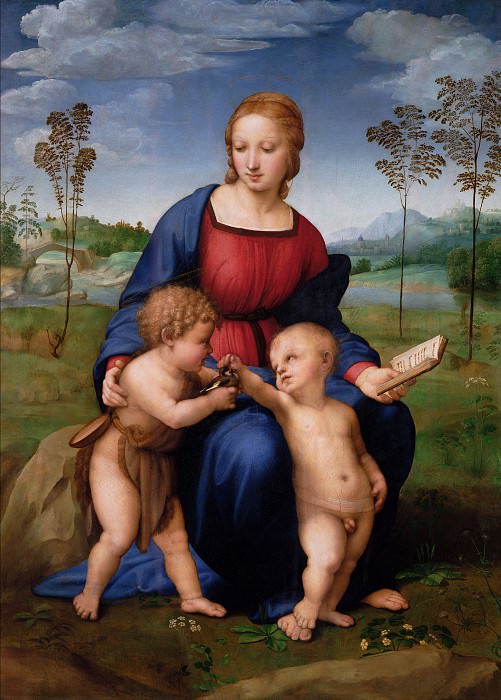Raffaello (Raffaello Sanzio) – Madonna of the Goldfinch Uffizi
Uffizi – Raffaello (Raffaello Sanzio) - Madonna of the Goldfinch
Edit attribution
Download full size: 3649×5100 px (4,2 Mb)
Back to album: Uffizi
The painting is made in the technique of oil painting on wood, its author is the famous Italian artist, representative of the Umbrian school - Raphael Santi. The painting dates from 1506 and is currently in the Galleria Ecclesiastical Galleries in Florence. The painting was once purchased by a French bourgeois, a wealthy merchant of expensive fabrics, on the occasion of his marriage. The house of the Nazi couple - the first owners of the painting - collapsed in 1547, at which time the canvas, damaged by the ruins of several other houses on the slope, was virtually destroyed - split into seventeen fragments. Raphael was commissioned by Nazi to paint a painting depicting the infants Jesus and St.
A description of Raphael Santi’s Madonna and Child
The painting is made in the technique of oil painting on wood, its author is the famous Italian artist, representative of the Umbrian school - Raphael Santi. The painting dates from 1506 and is currently in the Galleria Ecclesiastical Galleries in Florence.
The painting was once purchased by a French bourgeois, a wealthy merchant of expensive fabrics, on the occasion of his marriage. The house of the Nazi couple - the first owners of the painting - collapsed in 1547, at which time the canvas, damaged by the ruins of several other houses on the slope, was virtually destroyed - split into seventeen fragments.
Raphael was commissioned by Nazi to paint a painting depicting the infants Jesus and St. John. The Virgin Mary, with the infant Jesus standing at her feet, looks graciously as John hands him a little bird (a symbol of the Passion of Christ). The glances and gestures of the characters on the canvas form a "connecting chain", uniting their images into a single composition. Against the background of the classical "triangular" composition there is a landscape of the wide river, shrouded in a light haze.
The horizon seems endless because of the mountains, majestically towering over the river landscape. The bow and oak tree behind the Madonna and the infants do not distract the viewer’s attention, but rather create a greater "airy" volume in the background. The deep play of light and shadow creates additional volume, and the local colors in the Madonna’s clothing highlight her central figure and seem to create an "outline" of the entire foreground composition. Mary’s pose, hands and feet pointing to the right from the viewer’s point of view draw attention to the book, but at the same time her gentle gaze is directed at the infant infatuation.
Art historians, rightly note the similarities between Raphael’s Madonna and Leonardo’s, but distinguish their works by their particular tenderness, the absence of anxiety and restlessness in the images created by Raphael.
Кому понравилось
Пожалуйста, подождите
На эту операцию может потребоваться несколько секунд.
Информация появится в новом окне,
если открытие новых окон не запрещено в настройках вашего браузера.
You need to login
Для работы с коллекциями – пожалуйста, войдите в аккаунт (open in new window).


















COMMENTS: 1 Ответы
Божественно! И замысел и исполнение. Нет предела совершенству в руках такого Мастера с большой буквы. Великолепны как формы фигур и драпировок в обрамлении чудесного пейзажа, так и цветовой расклад. Всё отлично. Только хотелось бы узнать, что же такого сотворили реставраторы с головой младенца Христа, вернее, не что такого, а почему так искажена затылочная часть этой головы, – ведь, на репродукциях дореставрационной поры голова смотрится вполне нормально и гармонично по пропорциям? И, на мой взгляд, Рафаэль не мог так деформировать эту голову, что режет глаз, – нигде в других его работах такого более не наблюдается, – всё сверхгармонично и сверхсовершенно.
You cannot comment Why?